CHAPTER 21
The newest of methods of solving and calculating
Appendixes (I)
Contents
Ÿ Solving congruence and Diophantine equations by "H.M" table (New Method):
![]()
Ÿ Solving Diophantine equation of order in by "H.M" table:
![]()
Ÿ A new and fast method for calculating
"![]() " determinant (H.M method)
" determinant (H.M method)
Ÿ Definition of regular and irregular prime numbers by "H.M" determinant
Ÿ New method of calculation of sum of
"k-th" power of the first "n" natural numbers by
"H.M" determinant (expressing "![]() " via a
determinant)
" via a
determinant)
Ÿ Determining the number of roots of perfect cubic degree of equation directly by "H.M" method
Ÿ Proof of a new and applied "H.M" theorem (concerning the factorization of composite numbers)
21.1. Solving congruence and Diophantine equations
by "H.M" table (new method)
![]() (1)
(1)
We call number "n" as module, "x" as unknown, "a" as coefficient of unknown and "c" as constant number of congruence.
We know that if "![]() " and
according to multiplicative inverse of "a" namely
" and
according to multiplicative inverse of "a" namely ![]() (multiplicative
inverse of "a" in congruence):
(multiplicative
inverse of "a" in congruence):
![]()
Equation (1) can be written in below form:
![]()
Therefore, for solving equation (1), it is enough to calculate inverse of "a". We know that inverse of "a", (multiplicative inverse of "a") is calculated from below congruence equation:
![]() (2)
(2)
In equation (2) if ![]() and
and ![]() is
dividing residue of
is
dividing residue of![]() , we can write:
, we can write:
![]() (3)
(3)
Congruence equation (3) can be written in below Diophantine equation form:
![]() (4)
(4)
According to "![]() " and if
" and if ![]() is
dividing residue of
is
dividing residue of ![]() , we can write:
, we can write:
![]() (5)
(5)
As previous stage, congruence equation (5) can be written in below form:
![]() (6)
(6)
As the same method, If we continue this action, coefficient of unknown will be "1" and with return to previous stages, we can calculate "x" with a reversible method.
21.1.1. Attention.
We calculate all of above calculations with "4- row" table. This table has "4" rows that is completed after "4" stages.
For example we solve below congruence equation:
![]()
By using "H.M" table:
|
|
1378 |
621 |
136 |
77 |
59 |
18 |
|
|
2 |
1 |
|
|
1 |
-1 |
1 |
-1 |
1 |
-1 |
1 |
-1 |
1 |
|
|
|
621 |
136 |
77 |
59 |
18 |
5 |
3 |
2 |
1 |
|
|
|
537 |
242 |
53 |
30 |
23 |
7 |
2 |
1 |
1 |
|
21.1.2. Attention
Every table column, determines a congruence equation.
In this example, since![]() , so we must
calculate residue of dividing
, so we must
calculate residue of dividing ![]() and write it in second mesh
of first row (from the left side) beside the module
and write it in second mesh
of first row (from the left side) beside the module![]() .
.
Before explaining the table, we remind this point that for solving
every congruence equation, at first it is necessary to examine the condition![]() .
In congruence equation
.
In congruence equation![]() , if
, if![]() , so equation
has answer when "c" is divisible by
, so equation
has answer when "c" is divisible by![]() .
.
Therefore, for examining the condition![]() , at
first always we calculate successive division in below form and write the
obtained residue in first row of the table respectively. If the first row of
the table is ended to number "1", it shows that condition
, at
first always we calculate successive division in below form and write the
obtained residue in first row of the table respectively. If the first row of
the table is ended to number "1", it shows that condition ![]() is
established and if it is ended to zero and number before zero is greater than
"1", that number is the greatest common divisor of "a"
and "n".
is
established and if it is ended to zero and number before zero is greater than
"1", that number is the greatest common divisor of "a"
and "n".
Stage (1). We calculate successive divisions in below form and write obtained residues in first row of the table.
|
1999 |
1378 |
|
1378 |
621 |
|
|
1378 |
1 |
|
1242 |
2 |
|
|
|
|
|
|
|
|
|
|
|
|
|
|
|
|
621 |
136 |
|
3 |
2 |
|
|
544 |
4 |
, Ö , |
2 |
1 |
|
|
|
|
|
|
|
|
|
|
|
|
|
|
|
Stage (2). We write congruencyís constant number that
is "1" and "Ė1" successively in the second row of the table
(row![]() ) from left to right.
) from left to right.
Stage (3). We write the first residue (621) to the
last residue (1) another time in the third row (row![]() )
like the first row (ni).
)
like the first row (ni).
Stage (4). Always we suppose the last mesh of forth
row in right side of table (row![]() ) is equal to constant number (+1
or Ė1) of its column in second row. It is necessary to explain that in first
row, with condition
) is equal to constant number (+1
or Ė1) of its column in second row. It is necessary to explain that in first
row, with condition![]() , the number "1"
appears and so, division is finished.
, the number "1"
appears and so, division is finished.
For completing the forth row (row![]() ) of
the right side in successive "M" figures (according to figure
and in direction of arrows)
) of
the right side in successive "M" figures (according to figure
and in direction of arrows)
![]() We
act in this method (action of every row, is written at beginning of every row):
We
act in this method (action of every row, is written at beginning of every row):
![]()
We multiply the last number from the right side in forth row (537) in congruence constant number:
![]()
In the other hand, obtained residue of dividing number "537(1357)" or "728709" by "1378" is answer of congruence equation:
(Main answer of equation) ![]()
It is obvious that general answer of equation for arbitrary
integer value of ![]() is:
is:
(General answer of equation) ![]()
21.1.3. Example
Solve below congruence equation:
![]()
Solution. Since "![]() ", at
first we write obtained residue from division
", at
first we write obtained residue from division ![]() in the right
side of "module 19". Then we calculate successive divisions and write
obtained residues on first row of the table:
in the right
side of "module 19". Then we calculate successive divisions and write
obtained residues on first row of the table:
![]()
According to the above congruence, positive main answer of equation is:
![]() ;
; ![]()
|
|
19 |
7 |
5 |
2 |
1 |
|
|
1 |
-1 |
1 |
-1 |
|
|
|
7 |
5 |
2 |
1 |
|
|
|
|
-3 |
-2 |
-1 |
|
 21.1.4. Example
21.1.4. Example
Find inverse of number "1999" with "module 1980".
Solution. Mathematics expression of problem is below congruence equation:
![]()
Since![]() , we write residue of division
, we write residue of division ![]() in
the right side of "module 1980" and then we calculate successive
divisions.
in
the right side of "module 1980" and then we calculate successive
divisions.
21.1.5. Attention
Since always our purpose is positive answer of equation, therefore, it is enough to add number of module (1980) to number (-521) that the main answer of equation is obtained:
![]()
|
|
1980 |
19 |
4 |
3 |
1 |
|
|
1 |
-1 |
1 |
-1 |
|
|
|
19 |
4 |
3 |
1 |
|
|
|
|
-5 |
-2 |
-1 |
|
So, multiplicative inverse of number "1999" in "module 1980" is "1459".
21.1.6. Example
Verify below congruence equation about existing or non- existing
answer: ![]()
Solution. At first, we obtain the greatest common divisor of two numbers "3953" and "2680" with successive divisors and writing the residues.
|
|
3953 |
2680 |
1273 |
134 |
|
0 |
|
|
1 |
-1 |
1 |
-1 |
1 |
|
According to the table:
![]()
Since constant number of equation (176) isnít divisible by "67", so equation hasnít answer.
 21.1.7.
Example
21.1.7.
Example
Solve below congruence equation:
![]()
Solution. We solve the equation by forming the table:
(![]() )
)
|
|
77 |
69 |
8 |
5 |
3 |
2 |
1 |
|
|
1 |
-1 |
1 |
-1 |
1 |
-1 |
|
|
|
69 |
8 |
5 |
3 |
2 |
1 |
|
|
|
-29 |
-26 |
-3 |
-2 |
-1 |
-1 |
|
One answer of equation from infinite answers is:
![]()
Since we want positive answer of equation, therefore, we add
positive coefficient of module to this answer:
|
![]() ;
;
21.1.8. Example
Find inverse (multiplicative inverse) of number "34" with module "41".
Solution. This problem is equivalent with below congruence:
![]()
We solve the equation by forming table:
|
|
41 |
34 |
7 |
6 |
1 |
|
|
1 |
-1 |
1 |
-1 |
|
|
|
34 |
7 |
6 |
1 |
|
|
|
|
-5 |
-1 |
-1 |
|
![]() According
to the table, answer "
According
to the table, answer "![]() " will be obtained that for
finding positive answer; it is enough to add the module to it:
" will be obtained that for
finding positive answer; it is enough to add the module to it:
|
![]() ;
;
Therefore, inverse of number "34" is number "35" with module "41".
21.1.9. Problems
Ÿ By using the table "H.M", solve below congruence equations.
|
1) |
, |
2) |
|
3) |
, |
4)
|
|
5) |
, |
6) |
|
7) |
, |
8) |
21.1.10. Attention
This table has a lot of usageís that we explain the usage of table in solving linear Diophantine equations briefly. This table can be used for identifying the prime numbers and finding equivalent of exponential numbers etc.
21.2. Solving linear Diophantine equations by "H.M" table
![]()
We consider two-unknown Diophantine equation in below general form:
![]() (1)
(1)
We write equation (1) in below congruence equation form:
![]() (2)
(2)
Now, we solve equation (2) by table and determine value of![]() .
Then we obtain value of
.
Then we obtain value of ![]() from relation
from relation![]() .
.
21.2.1. Example
Solve below Diophantine equation.
![]() (1)
(1)
Solution. At first, we write the equation in below congruence equation form:
(2)
Now, we solve congruence equation (2) by the table:
![]()

|
|
17 |
8 |
1 |
|
|
1 |
-1 |
|
|
|
8 |
1 |
|
|
|
|
-1 |
|
21.2.2. Attention
If we have a special answer of equation (1), we can write general answer of
equation, because if ![]() is a special
answer of equation, then:
is a special
answer of equation, then:
![]()
If![]() , by subtracting the two
equations of system:
, by subtracting the two
equations of system:
![]()
In order to![]() , it is necessary to have:
, it is necessary to have:
![]()
Therefore, if![]() , answers of equation (1) will be
obtained from below equations:
, answers of equation (1) will be
obtained from below equations:
![]()
According to equations (3), general answer of equation ![]() is:
is:
![]()
21.2.3. Example
Solve below Diophantine equation.
![]()
Solution. At first, we write equation in below congruence equation form:
![]() (1)
(1)
Now, we must obtain product of (1340, 3953):
|
|
3953 |
1340 |
1273 |
|
0 |
|
|
1 |
-1 |
1 |
-1 |
|
Since the first row is ended to "Zero", it is results that numbers "1340" and "3953" have common factor "67":
![]()
![]() In the
other hand since
In the
other hand since![]() , therefore we can simplify
equation (1) to 67:
, therefore we can simplify
equation (1) to 67: ![]()
Here, for solving equation (2), we form the table:
|
|
59 |
20 |
19 |
1 |
|
|
1 |
-1 |
1 |
|
|
|
20 |
19 |
1 |
|
|
|
|
1 |
1 |
|
![]() According
to the table:
According
to the table:
![]()
If we have value of![]() , we can
calculate value of
, we can
calculate value of![]() :
:
![]()
Therefore, the general answer of equation is:
![]()
21.2.4. Example
Obtain positive and integer answers of below Diophantine equation:
![]() (1)
(1)
![]() Solution.†The greatest unknown coefficient is
coefficient of
Solution.†The greatest unknown coefficient is
coefficient of![]() , therefore:
, therefore:
![]()
So, we can write:
![]() (2)
(2)
With forming the table:
|
|
11 |
7 |
4 |
3 |
1 |
|
|
1 |
-1 |
1 |
-1 |
|
|
|
7 |
4 |
3 |
1 |
|
|
|
|
-2 |
-1 |
-1 |
|
![]()
According to below congruence:
![]()
Values of ![]() and
and ![]() are:
are:
![]()
As the same method:
![]() (3)
(3)
In this congruence equation, coefficient of unknown ![]() is
"7" and the module is
is
"7" and the module is ![]() according to congruence
(2). Therefore, answer of equation (3) according to the recent table is:
according to congruence
(2). Therefore, answer of equation (3) according to the recent table is:
![]()
Equation (1) hasnít integer answer for ![]() and
and![]() ,
so equation has two kinds of special answers
,
so equation has two kinds of special answers ![]() and
and ![]() that
we can obtain general answers of equation by using these special answers.
that
we can obtain general answers of equation by using these special answers.
21.2.5. Problems using the table "H.M" solve below Diophantine equations
1) If![]() , find integer numbers
, find integer numbers ![]() and
and
![]() so that below equation is
established.
so that below equation is
established.
![]()
2) ![]()
3) ![]()
4) ![]()
5) ![]()
21.3. Solving "n-th" degree Diophantine equation by "H.M" table
We consider below "n-th" degree Diophantine
equation, we determine positive values of ![]() and
and ![]() for
it:
for
it:
![]() (1)
(1)
For solving equation (1), we write it in below congruence equation form:
![]() (2)
(2)
It is obvious that condition of existing answer for equation
(2) or (1) is that![]() , so, equation (2) or (1) has
"m" two by two non-congruent answers (different answers) with
module
, so, equation (2) or (1) has
"m" two by two non-congruent answers (different answers) with
module![]() .
.
In the other hand, if![]() , we write
equation (1) in below form:
, we write
equation (1) in below form:
![]() (3)
(3)
By using the table (H.M), we solve equations (2) or (3).
By using the table (H.M), answers ![]() or
or
![]() will be obtained for (2) and (3)
respectively therefore, if
will be obtained for (2) and (3)
respectively therefore, if![]() , we gain these answers:
, we gain these answers:
![]() (I) ,
(I) , ![]() (II)
(II)
Here, If value of ![]() exists,
it is resulted from relation (II):
exists,
it is resulted from relation (II):
![]() (4)
(4)
If we consider ![]() and
and ![]() limits of
limits of
![]() will be determined:
will be determined:
![]() (5)
(5)
Positive and integer values of ![]()
![]() are
determined according to (5) and relation (II).
are
determined according to (5) and relation (II).
For example, we solve below fifth degree equation and we find its positive answers:
![]() (1)
(1)
At first, we write equation (1) in below congruence equation form:
![]() (2)
(2)
We simplify equation (2) and then solve it by table (H.M):
![]() (3)
(3)
According to the table (H.M):
|
|
29 |
4 |
1 |
|
|
1 |
-1 |
|
|
|
4 |
1 |
|
|
|
|
-1 |
|
|
Therefore, answers of equation (3) are:
![]() (4)
(4)
By substituting the values of ![]() in
(1):
in
(1):
![]() (5)
(5)
According to "![]() "
and "
"
and "![]() ", Suitable value of
", Suitable value of ![]() is
determined from equation (5):
is
determined from equation (5):
![]()
Here, by substituting ![]() in
equation (4),
in
equation (4), ![]() will be obtained:
will be obtained:
![]()
For another example, we solve below equation and obtain its positive answers:
![]()
Since we want positive answers of equation, therefore, we
determine limits of ![]() and
and ![]() .
.
![]()
If "![]() " ; then
" ; then ![]() or
or
![]() that it is enough to test
the
that it is enough to test
the
main equation only for five primitive natural numbers:
![]()
Therefore, an answer of equation is "![]() "
and "
"
and "![]() ".
".
Substituting another four natural numbers instead of ![]() (in
main equation), no other positive answer will be obtained.
(in
main equation), no other positive answer will be obtained.
21.3.1. Remark
If "![]() " and "
" and "![]() ",
then equation (1) is solvable easily, because, we can calculate limits of
",
then equation (1) is solvable easily, because, we can calculate limits of ![]() and
and
![]() in this case, it means that
we write equation (1) in "
in this case, it means that
we write equation (1) in "![]() " or "
" or "![]() "
form ("
"
form ("![]() "and "y" are
positive):
"and "y" are
positive):
![]()
21.3.2. Example
We solve below equation:
![]()
Since we want positive answers of above equation, we can
calculate limits of ![]() and
and ![]() from
the main equation:
from
the main equation:

By substituting three numbers that have been obtained for![]() ,
value of
,
value of ![]() and then
and then ![]() will
be obtained. Therefore, we have determined the only positive answer of equation
by limits check method. In this method, it is enough to determine the limits of
will
be obtained. Therefore, we have determined the only positive answer of equation
by limits check method. In this method, it is enough to determine the limits of![]() :
:
![]()
21.3.3. Remark
If ![]() be a prime number, equation
(1) changes to below easy and solvable form:
be a prime number, equation
(1) changes to below easy and solvable form:
![]() (6)
(6)
We write equation (6) by using the Fermatís (smaller)
theorem ![]() in below form:
in below form:
![]() (7)
(7)
Answer of equation (7) can be calculated by using the table (H.M) easily.
21.3.4. Example
We solve below 7-th degree Diophantine equation:
![]() (1)
(1)
Solution. According to![]() , we divide
equation (1) by "2":
, we divide
equation (1) by "2":
![]() (2)
(2)
We write equation (2) in below congruence equation form:
![]() (3)
(3)
According to Fermatís (smaller) theorem ![]() equation
(3) changes to below equation:
equation
(3) changes to below equation:

Therefore, answers of equation (1) are in below form:
![]()
Here, it is enough to calculate value of ![]() with
respect to
with
respect to![]() :
:

Answers of equation:
|
k |
0 |
1 |
2 |
Ö |
|
x |
2 |
9 |
16 |
Ö |
|
y |
5 |
683263 |
651914373 |
Ö |
21.4. A new and fast method for calculating of " "
determinant
("H.M" method)
"
determinant
("H.M" method)
For showing new method of calculation of determinant, it is enough to calculate some determinant in general and numeral cases. Therefore, we calculate third and forth order determinant in general and numeral case.
21.4.1 Calculation of third order determinant

Calculation method. According to the determinant
rules always we can suppose that medium element of first column namely ![]() is
non-zero
is
non-zero![]() . Therefore, we reduce
. Therefore, we reduce ![]() with
chain second order determinant method.
with
chain second order determinant method.
Action method. At first, we write second row another
time. In next stage, we put the obtained first column between second and third
column another time. Then we separate the obtained element to
"four-classes" in a ![]() determinant that we have a
determinant that we have a ![]() determinant
so that one of its elements is a
determinant
so that one of its elements is a ![]() determinant itself. At
last, for calculation of
determinant itself. At
last, for calculation of![]() , it is enough to divide the
obtained value by
, it is enough to divide the
obtained value by![]() .
.
Action stages. We write the second row another time and we put obtained first column between second and third column another time. Then separate the obtained element to "four-classes":
Stage 1:


Stage 2:

Every one of
"four-classes" forms a ![]() determinant. Then by
calculation of every one of
determinant. Then by
calculation of every one of ![]() determinants and general
determinant and dividing obtained number by
determinants and general
determinant and dividing obtained number by![]() , value of
, value of ![]() will
be calculated.
will
be calculated.
Stage 3:

Therefore ![]() is:
is:
![]()
After necessary abridgment:
![]()
21.4.2. Example
Calculate below determinant:

ŸCalculation with second order chain determinant method
1) We write the second row another time:
![]()

2) We write obtained first column another time:


3) We have separated to second order determinants:

4) We calculate the second order chain determinant:
![]()
5) We divide the second order chain determinant product by middle element of determinantís first column:
![]()
6) Calculated value of![]() :
:
![]()
21.4.3. Simplified method of chain determinant
Here, we present simplified and brief method of second order chain determinant. At first, we separate first column and perform actions on successive rows
in below form:
![]()
![]()

(According to the determinants rule, we suppose that "![]() ")
")

Here, we calculate example (1) (chain determinant of second order) by simplified method.
At first we separate the first column and perform actions on
rows and then we calculate "![]() ".
".
![]()

![]()

2) Calculation of forth order determinant in separation method (chain second order determinant):
With the same method, at first we reduce ![]() to
to
![]() and then reduce
and then reduce ![]() to
chain second order determinant like before.
to
chain second order determinant like before.
![]()

For separation "![]() " to
second order determinants, it is enough to write second and third rows another
time and write obtained first column alternately repeatedly and then we perform
the separation. Here, according to determinants rules, we suppose
" to
second order determinants, it is enough to write second and third rows another
time and write obtained first column alternately repeatedly and then we perform
the separation. Here, according to determinants rules, we suppose ![]() ,
,
![]() (like with changing two
rows or two columns). Therefore, always we can suppose that "
(like with changing two
rows or two columns). Therefore, always we can suppose that "![]() ,
,![]() ",
then with this hypothesis:
",
then with this hypothesis:
![]()

According to the determinant rules, we can suppose that
"![]() " and so:
" and so:

![]()
![]()
Now, we present simplified method of chain second order determinant:
At first we separate first column and then we perform the
actions on rows in below form (we suppose![]() ):
):
![]()
![]()

![]()

 (Final result)
(Final result)
21.4.4. Explain
It is necessary to explain that for calculation of the
"n-th" order determinant when![]() , simplified
method of chain second order determinant can be used also, because for higher
order of determinant, we need a method with higher speed. For calculation
, simplified
method of chain second order determinant can be used also, because for higher
order of determinant, we need a method with higher speed. For calculation![]() ,
we must attend that first column middle elements of every stage, namely
,
we must attend that first column middle elements of every stage, namely![]() ,
,![]() ,
,
![]() and Ö must be non-zero. For
example for calculation
and Ö must be non-zero. For
example for calculation ![]() , we must have
, we must have ![]() ;
because in stage(1) of
;
because in stage(1) of ![]() , we must have
, we must have ![]() ,
and in stage (2) of
,
and in stage (2) of ![]() , we must have
, we must have ![]() and
in stage (3) of
and
in stage (3) of ![]() , we must have
, we must have ![]() .
It is clear that according to determinants rules for every stage, this thesis
is certain and it hasnít any disorder to generality of problem.
.
It is clear that according to determinants rules for every stage, this thesis
is certain and it hasnít any disorder to generality of problem.
21.3.5. Example
Calculate "forth order" determinant by chain
second order determinant method.
![]()

Calculation with chain second order determinant method:
![]()
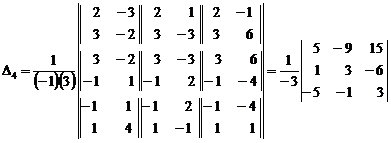
![]()
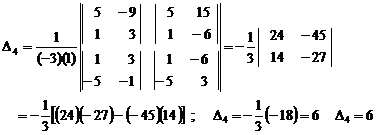
Here, we calculate example (21.4.5) by simplified method of chain second order determinant.
In order to this, at first, we separate the first column and perform the calculation on rows in below form (like third order determinant):
![]()

![]()
![]()
![]()

![]()
![]()
21.4.6. Example
Calculate below "fifth order" determinant.
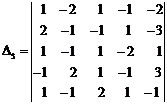
Solution. We perform calculation on rows and then we
obtain![]() ,
, ![]() and
and ![]() determinant.
determinant.
![]()

Product of determinant is:
![]()
![]()
21.5. Definition of regular and irregular prime numbers by "H.M" determinant
Below Congruence is result of theories related to verification of Fermatís last
theorem:
![]()
Here, Congruence ![]() is equivalent
with congruence
is equivalent
with congruence
![]() and below theorems are resulted
from congruence (1).
and below theorems are resulted
from congruence (1).
21.5.1. Theorem
Number ![]() is irregular if and only if
a number exists for
is irregular if and only if
a number exists for ![]() so that
so that ![]() is
divisible by
is
divisible by![]() .
.
21.5.2. Theorem
Number ![]() is regular if and only if
for every
is regular if and only if
for every![]() , number
, number
![]()
isnít divisible by![]() .
.
It is easier to consider the general sum:
![]()
It can be proved easily with mathematic induction that
numbers![]() , values of polynomial
, values of polynomial ![]() of
of
![]() degree for
degree for ![]() that
has rational coefficients (
that
has rational coefficients (![]() : Bernolliís numbers):
: Bernolliís numbers):
![]()
It is interesting that Bernolliís numbers entered into mathematics during solving one of astronomy problems.
![]()
The subject is that infinite sequence of Bernolliís numbers appears during converting some simple functions as power series. Like, we can prove:
![]()
This series was put against Bernolli during astronomy examinations.
This point that in series related to extension of ![]() ,
only Bernolliís numbers appear that have an even index, isnít randomly, because
we can prove easily that all of Bernolliís numbers that have odd index (except
number
,
only Bernolliís numbers appear that have an even index, isnít randomly, because
we can prove easily that all of Bernolliís numbers that have odd index (except
number ![]() ), are equal to "zero":
), are equal to "zero":
If ![]() then
then ![]()
Bernolliís numbers with even index![]() ,
have interesting characteristics. Like values of famous "Riemann's
function" (function
,
have interesting characteristics. Like values of famous "Riemann's
function" (function![]() ), can be expressed with respect
to Bernolliís numbers when have even power:
), can be expressed with respect
to Bernolliís numbers when have even power:
![]()
The first Bernolliís numbers are in this form.

The numerators of these fraction increase rapidly, For example:
![]()
Suppose:
![]()
is indicator of number![]() . Without
special difficulty we can prove that for
. Without
special difficulty we can prove that for![]() , denominator
, denominator ![]() from
number
from
number ![]() isnít divisible by
isnít divisible by![]() .
.
But, for every![]() , we have this equality:
, we have this equality:
![]()
It means:

Therefore, for![]() , the number in right side of
parenthesis is an integer number.
, the number in right side of
parenthesis is an integer number.
We return to previous congruence (module![]() ) and
we simplify it to
) and
we simplify it to![]() , so, the result is:
, so, the result is:
![]()
Therefore, congruence "![]() " is
established if and only if we have:
" is
established if and only if we have:
![]()
Therefore, we can present Kummer's theorem.
21.5.3. Kummerís theorem
Prime number ![]() is regular if and only if it is
not a divisor of numerators of Bernolliís numbers in "
is regular if and only if it is
not a divisor of numerators of Bernolliís numbers in "![]() "
form.
"
form.
We express some examples (see the Bernolliís numbers that we expressed before):
![]() isnít divisible by "5".
isnít divisible by "5".
![]() and
and ![]() arenít
divisible by "7".
arenít
divisible by "7".
![]() and
and ![]() arenít
divisible by "11".
arenít
divisible by "11".
![]() and
and ![]() arenít
divisible by "13".
arenít
divisible by "13".
![]() and
and ![]() arenít
divisible by "17".
arenít
divisible by "17".
![]() and
and ![]() arenít
divisible by "19".
arenít
divisible by "19".
![]() and
and ![]() arenít
divisible by "23".
arenít
divisible by "23".
Therefore, all of these powers are regular.
In other word, Fermatís last theorem is correct for powers "5,7,11,13,17,19 and 23".
21.4.4. Attention
In next section, you will be acquainted with "H.M"
new method of calculation of ![]() that is expressed by a
determinant.
that is expressed by a
determinant.
We present calculation ![]() by
determinant without proof ("H.M"
method):
by
determinant without proof ("H.M"
method):

21.5.5. Result
Since ![]() is a prime number and
is a prime number and![]() ,
so
,
so![]() .
.
Number ![]() is a regular prim number if and
only if
is a regular prim number if and
only if ![]() is not divisible by
is not divisible by ![]() for
every
for
every![]() .
.
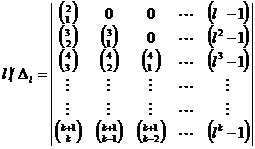
In fact, according to identification function of prime numbers, we can write:

Therefore, set of regular prime numbers is defined in below form:
(Set of regular prime numbers)

It is obvious that according to definition of set of regular prime numbers, set of irregular prime numbers can be defined by definition of prime numbers set:
(![]() : Set of irregular prime numbers)
: Set of irregular prime numbers)

Here, sets of regular and irregular prime numbers are
defined by expressing "![]() " and definition of prime
numbers set "IP".
" and definition of prime
numbers set "IP".
Calculation of "![]() ".
New method for calculating the sum of "k-th" power of
".
New method for calculating the sum of "k-th" power of ![]() natural
numbers
natural
numbers ![]() by determinant
by determinant
Here, we prove that "![]() "
calculates by below "k-th" order determinant:
"
calculates by below "k-th" order determinant:
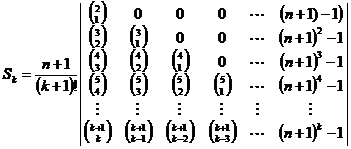
21.5.8. Result
Fermatís last theorem is correct for powers![]() .
.
21.5.9. Important result
Other sets can be defined by prime numbers formula.
Here, sets of regular and irregular prime numbers are
defined by expressing ![]() and definition of prime
numbers set "
and definition of prime
numbers set "![]() ".
".
21.6. New method of calculation of sum of "k-th" power of the
first "n" natural numbers by "H.M"
determinant
(expressing " " by a determinant)
" by a determinant)
![]()
Here, we prove that "![]() " can be
calculated by below "k-th" order determinant:
" can be
calculated by below "k-th" order determinant:
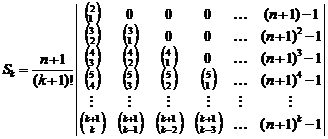
Proof: We know that if ![]() then:
then:
![]()
We put![]() ,
,![]() and
and ![]() in
above identity:
in
above identity:
![]()
Now, if we put values ![]() respectively
in above identity, we have below equality with adding obtained relations:
respectively
in above identity, we have below equality with adding obtained relations:
![]()
We write above equality in below form:
![]()
Now, if we put values ![]() respectively
for
respectively
for![]() , below system will be obtained
, below system will be obtained![]() :
:
![]()

So:
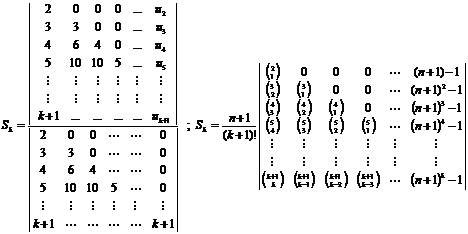
21.7. Determining the number of roots of perfect cubic degree equation directly by "H.M" method
![]() (1)
(1)
In equation (1), if we have:
![]()
then equation has a real root that is computable easily,
therefore for calculating the root of equation (1) it is enough to perform this
conversion ![]() and establish the above
mentioned conditions. As we know, after conversion we will have below equation:
and establish the above
mentioned conditions. As we know, after conversion we will have below equation:
 (2)
(2)
Now, for calculating![]() , we establish
the first condition namely
, we establish
the first condition namely![]() . After establishing this
condition we will see that value of
. After establishing this
condition we will see that value of ![]() is not
obtained.
is not
obtained.
Now, we establish the second condition, namely![]() .
And we will see that value of
.
And we will see that value of ![]() will be calculated.
Therefore:
will be calculated.
Therefore:
![]() (3)
(3)
After summarizing relation (3), we have below second degree
equation (with respect to![]() ):
):
![]() (4)
(4)
Here, for calculating the value of![]() , it
is enough to solve the second degree equation (4). After solving equation (4),
the value of
, it
is enough to solve the second degree equation (4). After solving equation (4),
the value of ![]() is:
is:
 (5)
(5)
Discriminant ![]() of cubic degree equation
(1) is obtained from value of
of cubic degree equation
(1) is obtained from value of![]() :
:
![]() (6)
(6)
Here, with obtaining such equation, we can discuss about the number of its roots:
1) If![]() , then equation (1) has a real
root and two complex roots.
, then equation (1) has a real
root and two complex roots.
2) If![]() , then equation (1) has an
additive root and one simple root.
, then equation (1) has an
additive root and one simple root.
3) If![]() , then equation (1) has three
real roots.
, then equation (1) has three
real roots.
21.7.1. Remark
In equation (1), If![]() , then the
equation is:
, then the
equation is:
![]() (7)
(7)
It means the focal equation of cubic degree will obtained.
Now, if we put value ![]() in Discriminant
in Discriminant ![]() of
equation (1), Discriminant
of
equation (1), Discriminant ![]() of focal equation (7) will
obtained:
of focal equation (7) will
obtained:
![]()
21.8. Proof of a new and applied "H.M" theorem
(Concerning the factorization of composite numbers)
21.8.1. "H.M" Theorem
If ![]() is divisible by "p"
and result of
is divisible by "p"
and result of ![]() is an odd number, then:
is an odd number, then:
![]()
Proof. For every ![]() and
and ![]() ,
we can write:
,
we can write:
![]() (1)
(1)
If ![]() is odd and according to
below equality for every odd
is odd and according to
below equality for every odd![]() :
:
(![]() : Number integer part)
: Number integer part)
(![]() is odd
number)
is odd
number) ![]()
So:
![]()
![]() (2)
(2)
21.8.2. Example
If ![]() is prime number, according
to Wilsonís theorem, expression
is prime number, according
to Wilsonís theorem, expression ![]() is divisible by
is divisible by ![]() and
conversely (If
and
conversely (If ![]() is divisible by
is divisible by ![]() and
and
![]() is a prime number).
Therefore, if
is a prime number).
Therefore, if ![]() is factorization in
relation (2) form,
is factorization in
relation (2) form, ![]() is a prime number:
is a prime number:
![]() (3)
(3)
21.8.3. Example
 21.8.4. Example
21.8.4. Example
I. If ![]() then:
then:
(p: prime number)

II. If ![]() then:
then:

